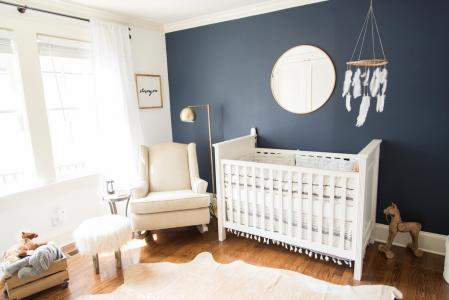
How To Create a Safe, Gentle, Toxic-free Nursery
If you’re expecting a baby, you probably want to prepare the best possible space for them in your home—a room where they can rest peacefully and grow healthy and strong. If you choose safe, environmentally-friendly products, you can also enjoy decorating your baby’s room without worrying about dangerous fumes or toxins while you work!
Here are a few tips to help ensure your nursery decor includes wholesome materials:
Wallpaper, Paint, and Wood Finishes
Little ones like to “taste” everything. It’s a natural developmental tool that helps them learn about their environment. It can be a problem, however, if they decide to taste-test nursery room walls that have paint or wallpaper made from toxic ingredients.
Look for wallpaper that is eco-friendly and 100% non-toxic, including inks. Use non-toxic paste to secure the paper to nursery room walls.
Keep in mind that any volatile organic compounds (VOCs) used in paints will continue to release toxins for years after the paint has dried. For nursery rooms, choose paints that are labeled low-VOC (preferably less than one level per pint) or VOC-free.
Several conventional paint chemicals are not considered VOCs, but should also be avoided. Try to select paints that are fungicide free, low in biocides, use natural pigments, and are free of crystalline silica and masking agents.
If you plan to include wood furniture or wood trim in your baby’s room, look for vegetable oil-based finishes and natural wax-based wood sealers.
Textiles
Natural fabrics like cotton and wool are frequently processed in ways that make them bad candidates for your baby’s room. Be sure textiles—especially those that will be against your baby’s skin (clothing, bed linens, towels, etc.)—have not been processed with toxic dyes, chemicals, and heavy metals.
Organic isn’t necessarily toxin-free. Organic refers to the way fibers are grown, not the way they are processed, dyed, finished, or chemically treated after they harvesting.
OEKO-TEX®’s Standard 100 certification is a global standard that helps ensure manufacturers’ textile products are free of harmful chemicals. Look for OEKO-TEX® certification labels or consult their Buying Guide.
Don’t forget these guidelines when selecting rugs, carpet, curtains, fabric wall hangings, and other textiles used in your baby’s room.
Pajamas pose unique issues in the U.S., where federal law requires children’s sleepwear to be flame-resistant. Even though two of the most dangerous fire-retarding chemicals (brominated and chlorinated tris) were banned in 1977, concerns remain about the potential impact of “safer” chemicals.
Fortunately, the Consumer Product Safety Commission introduced a loophole in the law that allows tight-fitting pajamas to be made free of fire retardants. (The theory is that tight-fitting clothes are less likely to burn since there’s less air circulation.)
So, to avoid chemicals on your baby’s PJs, look for tags that indicate natural fibers and say “must be snug fitting” and “not flame resistant.” (If you remain concerned about protecting your children from fire risks, it’s much more important to focus on smoke detectors.)
Safe for Them, Safe for You
Even though there is a growing awareness of eco-friendly products, various toxic paints, finishes, textile processes, and materials remain in mainstream use.
Although it’s easy to overlook or be unaware of less-than-ideal practices, it may be even more important to avoid them during your pregnancy and your child’s developmental years!
